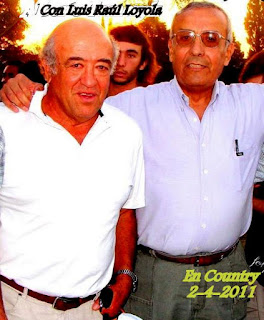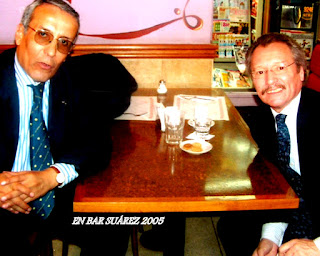Hace 20 años Nelson Mandela, cambió la historia del rugby sudafricano y del rugby mundial, en la V Copa del Mundo de Sudáfrica 1995, cuya final del sábado 24 de junio proclamó campeones a los Springboks sobre los All Blacks por 15-12 en el mítico Ellis Park de una Johannesburgo en fiesta popular.
Allí el anciano caballero vestido
de verde, un Nelson Mandela icono del anti-apartheid (cultura
y razas separadas) sudafricano, nos dejó una lección de humanidad y hoy a 20
años de esa manifestación recordamos al más grande estadista del siglo pasado,
Presidente de Sudáfrica y Premio Nobel de la Paz. Venerado en un país donde pasó 27 años de su
vida en la cárcel de Robbe Island en el extremo sur, en el Cabo de Buena
Esperanza, Nelson Madiba Mandela, que llevó a Sudáfrica a la democracia, se convirtió en su primer presidente
negro. Las dificultades que todavía transita
hoy la nación del arco iris, no borra la grandeza de esa elección del Presidente que estuvo encarcelado 27 años por
combatir contra la vergüenza del apartheid. Por eso fue
inolvidable aquel momento que viví en Ellis Park, en Johannesburgo con
Sudáfrica y Nueva Zelanda luchando por
el título de campeón mundial y con Nelson Mandela, premiando a los vencedores delante de un país
de 54 millones de habitantes que aprenden a vivir con igualdad de derechos y de deberes
como de obligaciones. Mientras tanto sigue el esfuerzo por integración en el
rugby, y que está limitado a un sistema de cuotas para incrementar número de negros
y mestizos en los equipos provinciales y selecciones nacionales. Como hace 20
años, sigue repiqueteando en mi mente el canto callejero del "Shosholoza", canción de los
mineros que se convirtió en banda sonora
de la nueva Sudáfrica.
NELSON MANDELA 20 YEARS AGO LEFT AN ICON OF FREEDOM AT ELLIS PARK

20 years ago, Nelson Mandela changed the history of South
African rugby and the rugby in the world, with the V Rugby World Cup South
Africa 1995, whose end on Saturday June 24, proclaimed champions to the Springboks over
All Blacks by 15-12 at the mythical
Ellis Park in a Johannesburg in the popular festival. There the elderly gentleman dressed in green, a Nelson
Mandela the an icon of South African anti-apartheid (culture and separate
races), and left us a lesson of humanity and today 20 years after from that demonstration, we remember the greatest
statesman of the century, President of South Africa and Nobel Prize. Revered by his country where he spent 27 years of his
life in prison of Robbe Island at the southern end at the Cape of Good Hope, Nelson
Madiba Mandela, who led South Africa to democracy, became its first Black
President. The difficulties which still today the nation of Rainbow,
not delete the greatness of that election of the President who was imprisoned
27 years for fighting against the shame of apartheid. Was unforgettable that time that I lived in Ellis Park,
Johannesburg with South Africa and New Zealand battling for the title of world
champion and with Nelson Mandela, rewarding the winners in front of a country
of 54 million people learning to live with equal rights and duties and
obligations. Meanwhile follow integration effort in the rugby, and
that is limited to a quota system to increase the number of blacks and coloured
in the provincials teams and nationals
selections . But 20 years ago, still rattling in my mind the street singing
"Shosholoza", song by the miners who became the soundtrack of the new
South Africa.
NELSON MANDELA 20 ANS DÉJÀ À LAISSE AU ELLIS PARK UNE ICÔNE DE LIBERTÉ
Il ya 20 ans, Nelson Mandela a
changé l'histoire du rugby sud-africain et de le rugby dans le monde, avec le
Vme Coupe du Monde de l’Afrique de Sud 1995, dont le samedi 24 Juin à proclamé champions aux Springboks sur les All
Blacks par 15-12 à la mythique scène du Ellis Park de Johannesburg dans la fête
populaire. Là, le vieux monsieur habillé
en vert, un Nelson Mandela l'une icône de la lutte anti-apartheid en Afrique du
Sud (culture et races séparées), et nous a laissé une leçon d'humanité et
aujourd'hui 20 ans après, que nous nous souvenons de démonstration le
plus grand homme d'Etat du siècle, Président de l'Afrique du Sud et Prix Nobel. Vénéré par son pays où il a
passé 27 ans de sa vie en prison dans l'île de Robbe à l'extrémité sud, au Cap
de Bonne-Espérance, Nelson Mandela Madiba, qui a dirigé l'Afrique du Sud à la
démocratie, est devenu le premier président noir. Les difficultés qui encore
aujourd'hui la nation de l’arc-en-ciel, non supprime pas la grandeur de cette élection du Président
qui a été emprisonné 27 années pour la lutte contre l’honte de l'apartheid. Était inoubliable que le temps
que je vivais à Ellis Park, Johannesburg avec l'Afrique du Sud et la Nouvelle-Zélande
se battre pour le titre de champion du monde et avec Nelson Mandela,
récompensant les gagnants en face d'un pays de 54 millions de personnes qui
apprennent à vivre avec l'égalité des droits et des devoirs et des obligations. En attendant de suivre les
efforts d'intégration dans le rugby, et qui est limité à un système de quotas
pour augmenter le nombre de noirs et de gens de couleur
dans les équipes provinciales et séléctions nationales. Mais il ya 20 ans,
encore cliquetis dans mon esprit la rue en chantant le "Shosholoza",
chanson des mineurs qui sont devenus la bande sonore de la nouvelle Afrique du
Sud.
NELSON MANDELA 20 ANNI HA LASCIATO UN ICONA DI LIBERTÀ ALL'ELLIS PARK

20 anni fa, Nelson Mandela ha cambiato la storia del rugby sudafricano e pure del rugby del mondo, nel V Coppa del Mondo, Sudafrica 1995, il cui termine sabato 24 giugno ha proclamato campioni gli Springboks sulla compagine dei All Blacks per 15-12 nel mitico Ellis Park di una Johannesburg in festa popolare. C'è l'anziano signore vestito di verde, un Nelson Mandela che è l'icona sudafricano anti-apartheid (cultura e razze separate), e ci ha lasciato una lezione di umanità ed oggi à 20 anni da quella manifestazione ricordiamo il più grande statista del secolo, il presidente del Sudafrica e Premio Nobel della Pace. Venerato dal suo paese dove ha trascorso 27 anni della sua vita in prigione nell’Isola di Robbe a sud del Capo di Buona Speranza, Nelson Madiba Mandela, ha guidato il Sudafrica alla democrazia, divenne il primo presidente nero. Le difficoltà che ancora oggi patisce la nazione dell’arcobaleno, no cancela la grandezza di quella elezione del Presidente che è stato imprigionato 27 anni per la lotta contro la vergogna dell'apartheid.
Era indimenticabile quel periodo
che ho vissuto a l’Ellis Park di Johannesburg con il Sud Africa e la Nuova
Zelanda in lotta per il titolo di campione del mondo e con Nelson Mandela, consegnando
il premio ai vincitori di fronte a un paese di 54 milioni di persone che impara
a vivere con pari diritti e doveri ed obbligazioni. Nel frattempo segue lo sforzo di integrazione nel rugby, e che si
limita a un sistema di quote per aumentare il numero di neri e dei colorati
nelle squadre provinciali e nazionali. Ma 20 anni fa, ancora risuonano nella mia mente
la gente cantando per le strade lo "Shosholoza", la canzone dei
minatori che divenne colonna sonora del nuovo Sudafrica.





















